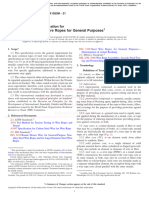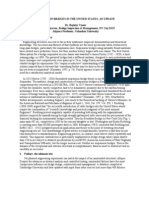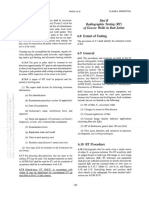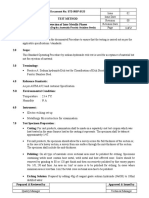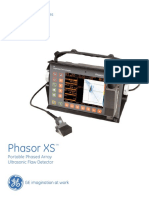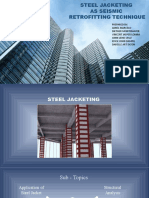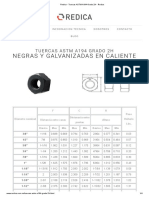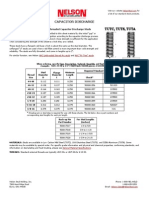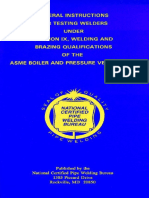Professional Documents
Culture Documents
Process Specification For The Manual Arc Welding of Titanium Alloy Hardware
Process Specification For The Manual Arc Welding of Titanium Alloy Hardware
Uploaded by
Faiz NanafiOriginal Description:
Original Title
Copyright
Available Formats
Share this document
Did you find this document useful?
Is this content inappropriate?
Report this DocumentCopyright:
Available Formats
Process Specification For The Manual Arc Welding of Titanium Alloy Hardware
Process Specification For The Manual Arc Welding of Titanium Alloy Hardware
Uploaded by
Faiz NanafiCopyright:
Available Formats
PRC-0002 Rev.
Process Specification for the Manual Arc Welding of Titanium Alloy Hardware
Engineering Directorate
Structural Engineering Division
December 2003
National Aeronautics and Space Administration Lyndon B. Johnson Space Center Houston, Texas
Verify correct version before use. Page 1 of 20
PRC-0002 Rev. B
Process Specification for the Manual Arc Welding of Titanium Alloy Hardware
Prepared by :
Signature on File Daniel J. Rybicki Materials and Processes Technology Branch/ES4
12/30/03 Date
Approved by:
Signature on File Jose M. Hernandez, Chief, Materials and Processes Technology Branch/ES4
12/31/03 Date
VERSION -A
Original version Formatting, changed process owner, rewrite numerous sections for clarification, deleted requirement for WIR, deleted section 8.2 on audits, added section 8.3 on WPQ, deleted mil specs for NDE, added PRCs for NDE. Comprehensive rewrite to combine PRC-0002 and PRC-0004 and make editorial changes. PRC-0004 will be cancelled with this change. Include requirements for precision cleaned hardware (ref. JPG 5332.1).
REVISIONS DESCRIPTION
DATE 6/1/95 07/07/99
12/30/2003
Verify correct version before use. Page 2 of 20
PRC-0002 Rev. B
1.0
SCOPE
This process specification provides the minimum requirements that govern the manual arc welding of titanium alloy flight and non flight hardware. Procedural and quality assurance requirements are given. All work instructions and Welding Procedure Specifications (WPS) used during welding shall satisfy the requirements of this process specification and its applicable documents. 2.0 APPLICABILITY
This process specification applies to manual arc welding of titanium alloy flight and non flight hardware that is fabricated under the authority of NASA/Johnson Space Center (JSC) by any of the following types of welding processes: a. b. Gas tungsten arc welding (GTAW) Plasma arc welding (PAW)
The Gas Metal Arc Welding (GMAW) process is not considered an acceptable process for welding titanium alloys under this process specification. Future builds of hardware where the existing engineering documentation calls out NASA/JSC PRC-0004 for welding of shall utilize this specification. Existing hardware fabricated to PRC0014 requirements shall not be affected by this change. 3.0 USAGE
This process specification shall be called out on the engineering drawing by a drawing note with the following general format which specifies the PRC and weld class nomenclature: WELD AND INSPECT PER NASA/JSC PRC-0002, CLASS X To minimize fabrication costs by avoiding over-inspection and unnecessary rework/repair, individual welds, or components on a weldment shall be classified separate where possible. This can be accomplished by including a note on the engineering drawing with the general format shown below which specifies only the PRC nomenclature. The weld class shall then be indicated by either: 1) calling out the specific weld class with the welding symbol at the individual weld joints or, 2) by using specific flag notes with the welding symbol at the individual weld joints. Refer to Figure 3.0a and 3.0b below for examples of these methods. WELD AND INSPECT PER NASA/JSC PRC-0002. WELD CLASSES SHALL BE AS INDICATED AT WELD LOCATION CALLOUTS.
CLASS B WELD
FIGURE 3.0a
Verify correct version before use. FIGURE 3.0b Page 3 of 20
PRC-0002 Rev. B
3.1
WELDING CLASSES
Welds made using this specification shall be primarily classified in accordance with the service conditions of the weldment. Therefore, the "Class" defines the severity of service intended for the joint by design and governs the extent to which quality assurance provisions are applied to the weld joint as specified herein. Alternatively, individual welds, welded connections, or entire weldments may be classified by relating the weld to the factor of safety used in the design. However, when classifying welds in this manner, regardless of the factor of safety, adequate consideration should be given to the severity of the service condition (e.g., static loading vs. dynamic loading, cyclic, vibration, fatigue, corrosive, extreme temp, etc.), material characteristics (e.g., ductility, toughness, etc.), and the potential consequences of weld failure. Where conditions exist that make it difficult to choose between 2 weld classes, the more stringent of the 2 classes shall then be applied. Quality assurance provisions for all weld classes are detailed in Section 7.0. Weld classes shall be chosen on the basis of the following definitions: Class A Applies to welds in critical load bearing elements that are not failsafe. Class A welds are typically used in primary load bearing connections. Failure of a Class A weld in service is expected to be catastrophic and would likely result in the loss of life, system(s), control, or major components. Alternatively, if it is determined from appropriate engineering analyses that a weld has a Factor of Safety (FS uts) vs ultimate tensile strength of the calculated minimum weld throat cross section of <2.0, it shall be designated as a Class A weld.
a.
Class B Applies to welds in load bearing elements that are fail-safe. Class B welds are typically used in secondary load bearing (i.e., shared load) connections. Failure of a Class B weld in service is expected to be serious and would likely reduce the overall efficiency of the system, but the loss of a system(s) or major components or endangerment to personnel is not expected. Alternatively, if it is determined from appropriate engineering analyses that a weld will have a FSuts of 2.0 and <4.0, it may be designated as a Class B weld.
b.
Class C Applies to welds that are in minor load bearing elements that are fully contained where failure in service is expected to have minor or no affect on the efficiency of a system and endangerment to personnel would not occur. Class C welds are typically used in secondary or tertiary load bearing (i.e., shared load) connections. Alternatively, if it is determined from appropriate engineering analyses that a weld will have a FSuts of 4.0, it may be designated as a Class C weld.
c.
In addition to the above definitions, the following requirements shall also apply to weld classifications:
Verify correct version before use. Page 4 of 20
PRC-0002 Rev. B
If any weld intersects or overlaps another weld of a higher classification, then the lower classed weld shall be automatically upgraded to the higher of the 2 weld classes and subjected to the appropriate quality assurance provisions. If any weld falls within of any higher classed weld, then it shall be automatically upgraded to the higher of the 2 weld classes and subjected to the appropriate quality assurance provisions. 3.2 WORK INSTRUCTIONS
Work instructions shall be used for implementing this process specification. The work instructions shall contain sufficient detail to ensure that the manufacturing process produces consistent, repeatable results that comply with this specification. At JSC, these work instructions are approved as Detailed Process Instructions (DPIs) that describe in a detailed, step-by-step format the required procedures, equipment, and materials to be used for conducting a given process. If this manufacturing process is to be performed by an outside vendor, work instruction development shall be the responsibility of the vendor. 3.3 a. DESIGN REQUIREMENTS The design of welded joints (including weld sizes) shall utilize adequate engineering analysis methods (e.g., stress analysis, fracture mechanics/fracture control, FEA, FMEA, etc.) to ensure that the resultant connection strength is capable of successfully transferring the maximum load expected to pass between the interconnecting members and meet the required factors of safety and design margins. All engineering drawings shall depict welded joints using the applicable symbols described in AWS A2.4. The engineering drawing shall specify any additional or alternate testing or inspection requirements. Where spot, intermittent, or other special inspection requirements are specified that deviate from those stated herein, it shall be detailed on the drawing as a note or by using the applicable symbology described in AWS A2.4. For Class A welds, alternate or reduced NDE requirements shall not be allowed. Class A welds are expected to be welds requiring full strength of the weld joint therefore, these welds shall be a groove design and full penetration wherever possible. The ability to successfully perform radiographic examination on these weld joints shall be considered during design. Except for titanium alloy 6Al-4V welded with 6Al-4V filler metal, hardware will be delivered in the as welded condition unless otherwise specified on the engineering drawing. If required, the engineering drawing shall include notation that will specify an appropriate heat treatment process, referencing SAE AMS-H81200. For welds in alloy 6Al-4V welded with 6Al-4V filler metal, a stress relief heat treatment at 1100o F for 2 hours (vacuum or inert gas atmosphere) shall be required. Intermittent welding (skip welds) shall not be specified for Class A joints.
b. c.
d.
e.
f.
Verify correct version before use. Page 5 of 20
PRC-0002 Rev. B
g.
Intermittent welds shall not be specified for butt welds (square or groove design) unless the unwelded portions of the joint are adequately supported to prevent one member from coming out plane with the adjoining member. Weld filler material shall be specified on the engineering drawing in the parts list. REFERENCES
h. 4.0
The standards listed below shall be considered a part of this specification to the extent specified herein. Unless otherwise indicated, the revision that is in effect on the date of invitation for bids or the date of request for proposals shall apply. a. American Society of Nondestructive Testing (ASNT) Personnel Qualification and Certification in Nondestructive Testing
SNT-TC-1A b.
American Welding Society (AWS) Standards Standard Symbols for Welding, Brazing and Nondestructive Testing Standard Welding Terms and Definitions Specification for Tungsten Arc Welding Electrodes Specification for Titanium & Titanium Alloy Welding Electrodes & Rods Standard for Welding Procedure and Performance Qualification Structural Welding Code Stainless Steel Standard for AWS Certification of Welding Inspectors
ANSI/AWS A2.4 ANSI/AWS A3.0 ANSI/AWS A5.12 ANSI/AWS A5.16 ANSI/AWS B2.1 ANSI/AWS D1.6 ANSI/AWS QC-1 c.
Compressed Gas Association, Inc. Argon, Commodity Specification for
G-11.1 d.
Federal Documents Helium Federal Specification
BB-H-1168 e.
Military Documents Argon, Technical Propellant Pressurizing Agent, Helium
MIL-A-18455 MIL-P-27407 f.
NASA/JSC Documents Contamination Control Requirements Manual Process Specification for the Qualification of Manual Arc Welders
Verify correct version before use. Page 6 of 20
JPG 5322.1 PRC-0008
PRC-0002 Rev. B
PRC-6503 PRC-6504 PRC-6506 SOP-004.5 SOP-007.1 TI-0000-04 g.
Process Specification for Radiographic Inspection Process Specification for the Ultrasonic Inspection of Wrought Metals Process Specification for Liquid Penetrant Inspection Control of Weld Filler Materials, Electrodes, and Fluxing Materials Preparation and Revision of Process Specifications Training Instruction for the Welding Processes
NASA Headquarters
NASA-SPEC-5004 Welding of Aerospace Ground Support Equipment and Related Nonconventional Facilities NASA-STD-5006 h. General Fusion Welding Requirements for Aerospace Materials Used in Flight Hardware
SAE Aerospace Material Specification Heat Treatment of Titanium and Titanium Alloys
AMS-H-81200 5.0
MATERIAL REQUIREMENTS
All base materials used in the welding of hardware per this specification, shall meet the requirements of an applicable JSC material specification unless otherwise specified. If a JSC material specification is not available, then an applicable commercial specification or a manufacturer's specification shall be used. Requirements for filler metals and electrodes are listed in 5.2. Filler metals and electrodes purchased to alternate specifications shall be allowed provided they meet the minimum requirements of the specifications listed herein. 5.1 SHIELDING GASES
Allowable shielding gases (including purge gases) are listed in Table I. Gases purchased to alternate specifications shall be allowed provided they meet the minimum requirements of the specifications listed herein. Mixtures of these gases are allowed and the nominal mixture used for the qualification welding shall be that used for production and shall be listed on the WPS. All shielding and purging gases and nominal gas mixtures shall be treated as an essential procedure qualification variable and shall be subject to the AWS B2.1 requirement for these variables. In addition: a. All gases used for welding shall be delivered through clean low-nonvolatile residue (NVR)/particulate tubing. b. Nitrogen or hydrogen gas in any concentration, shall not be used for shielding or purging in any welding operation governed under this specification.
Verify correct version before use. Page 7 of 20
PRC-0002 Rev. B
c. All gases used for shielding or purging shall have a dewpoint of -60F (-51 C) or better and oxygen content shall not exceed 50 ppm. Table I. Allowable Shielding Gases GAS Argon Argon Helium Helium 5.1.1 Weld Atmosphere A protective weld atmosphere shall be freely accessible to all portions of the joint. The weld atmosphere for inert gas chambers, and gas supplies for trailing shields shall be monitored for moisture and oxygen content. 5.1.2 Weld Atmosphere Purity Test Atmospheric purity shall be verified by making an autogenous fusion pass on a commercially pure (CP) titanium strip, which has been properly cleaned. A fusion zone and heat affected zone with a bright silver or light straw color is acceptable (condition #1 or #2 below). No tacking or welding shall be performed on production hardware until an acceptable color has been obtained. Weld discoloration condition in increasing order of contamination is: 1.bright silver - acceptable 2.light straw - acceptable 3.dark straw - unacceptable 4.purple - unacceptable 5.dark blue - unacceptable 6.yellow unacceptable 7.grey - unacceptable 8.white (may have loose powder) unacceptable 9.brushed unacceptable (welds that have been brushed before inspection are rejectable regardless of color before brushing) 5.2 FILLER METALS AND ELECTRODES DESCRIPTION Gas Type II, Grade B (Liquefied) Type I, Grade A Grade A SPECIFICATION MIL-A-18455 CGA G-11.1 MIL-P-27407 BB-H-1168
Filler metals shall be selected based on specific base metals being welded, service conditions, design requirements (load conditions, etc.), and other design or service factors. The specific selection must be approved by the NASA/JSC Materials & Processes (M&P) organization prior to use. In addition, the following shall apply: a) Filler and electrode materials used shall conform to the applicable AWS specifications listed herein. Filler metals and electrodes purchased to alternate
Verify correct version before use. Page 8 of 20
PRC-0002 Rev. B
specifications shall be allowed provided they meet the minimum requirements of the specifications listed herein. b) Filler metals shall be manufactured by a high-quality (HQ) method involving multiple melt cycles. In addition, the final melt cycle shall be made under vacuum. Wherever possible, filler metals designated as extra-low interstitial (ELI), shall be used. Where the end product will be used in a cryogenic application, then ELI filler metals shall be used. Weld filler metals shall be called out on the engineering drawing in the parts list. Non consumable tungsten and tungsten alloy electrodes for GTAW and PAW shall be selected according to the process being used at the direction of the responsible M&P organization. The electrode type and size shall be specified on the WPS.
c) d) e) f)
5.2.1 Control and Storage Welding electrodes and filler metals shall be stored in a clean, dry, and controlled area that provides protection from contamination, physical damage, commingling of alloys and loss of identification/traceability. Any form of electrodes or weld filler metal which is damaged, dirty, exhibits oxidation/corrosion or has been contaminated with water, oil, grease or any form of hydrocarbons shall not be used and shall be disposed of in accordance with an appropriate disposal procedure. For JSC operations, welding electrodes and filler materials shall be controlled in accordance with SOP-004.5. Outside vendors shall provide control and storage according to the applicable material specification or manufacturer's recommendation, whichever is more rigid. 5.3 MECHANICAL PROPERTIES
Unless otherwise specified, minimum mechanical properties that determine an acceptable weld qualification for titanium alloys shall be that as specified in AWS B2.1. In addition, when qualifying a WPS using a titanium alloy not listed in AWS B2.1 the diameter of the plunger (dimension A in Annex II of AWS B2.1) used for the guided bend test shall not exceed 20T (10T radius). 5.4 Welding Chambers and Trailing Gas Shielding
When an inert gas or vacuum chamber is used for welding or trailing torch shields and/or a trailing or fixed gas purge assemblies are used, the specific equipment and method shall be considered an essential variable during qualification of the WPS and personnel qualifications. 6.0 PROCESS REQUIREMENTS
All weldments shall be fabricated according to the requirements of this process specification and shall be performed using Welding Procedure Specifications (WPS) that have been qualified in accordance with the requirements of Section 8.0 in addition to that as detailed below. In addition, when qualifying a WPS for titanium welding, the welding setup shall be
Verify correct version before use. Page 9 of 20
PRC-0002 Rev. B
considered an essential variable. WPSs qualified outside of a weld chamber using trailing shields and gas purge assemblies may also be used for welding in a weld chamber, but not vice versa. REQUIREMENTS FOR ALL PROCESSES 6.1.1 Preweld Cleaning of Weld Joint Surfaces Prior to welding, all weld joint surfaces within a minimum of of the weld line shall be cleaned in a manner shown to be adequate and repeatable in producing a surface cleanliness level conducive to producing sound welds by a given weld process. The specific process and procedural steps to carry out the process shall be part of the procedure qualification activities and shall be appropriately detailed on the qualification and procedure specification (PQR and WPS) documentation as well in the production work instructions. Personnel shall be trained in these same methods and process techniques. 6.1.2 Intermittent Welding Applicable to all processes, unless otherwise specified, weld joints that are specified for intermittent welding shall have the ends of the parts, or departure from a straight weld line (e.g., square corner, etc.), welded regardless of the interval of the weld. 6.1.3 Tooling and Fixturing Weldments shall be fixtured with appropriate tooling as deemed necessary by the fabricator. Tools and fixtures shall be constructed of materials that will not interefere with the welding process nor damage or contaminate the hardware. 6.1.4 Temporary or Tack Welding Temporary (includes the term tack welding) welding in areas of the hardware not planned for welding or where the temporary weld will not be totally consumed by the final weld, shall not be allowed. All temporary welds placed at or in a weld joint shall be ground or feathered by welding appropriately to accommodate the final welding process to achieve the expected deposit of sound weld metal. All temporary and tack welding shall only be performed by a welder(s) whose qualifications are current and applicable. 6.1.5 Welding Equipment Equipment (e.g., power supplies, positioners, flowmeters, etc.) used for manual welding operations need not have calibrated instrumentation (dials, gauges, indicators, meters, etc.). However, reference indicating instrumentation (e.g., dials, meters, gauges, etc.) shall be fully functional (i.e., useful output) and in good working order. The equipment shall be capable of being used by a qualified welder, using a qualified procedure, to produce sound and contaminant free welds. At the discretion of the responsible M&P organization, specific equipment instrumentation and metering devices may be calibrated to ensure repeatability of the process. 6.1.6 Welding Precision Cleaned Hardware (including tube preparation for welding) Whenever precision-cleaned hardware must be maintained clean during welding into an assembly, the welding operation shall be performed in a dedicated Class 100,000 Clean
Verify correct version before use. Page 10 of 20
PRC-0002 Rev. B
Work Area. This may require temporary tents over the weld area and/or local monitors located in the area of welding to ensure the Class 100,000 environment is being met. Portable particle counters shall be located as close as possible to the work area, so as to monitor local contaminants during tube preparation and welding. Tools used in weld preparation and welding (such as cutter, weld head, files) shall be visibly cleaned per JPG 5322.1 and maintained clean (e.g. bagged when not in use). For hardware that cannot be subsequently precision-cleaned, a proven method for protecting against system contamination during tube preparation and welding shall be implemented. One such method is the use of a physical barrier, such as plugs. The installation and removal of plugs shall be tracked by a reliable method and independently verified. Prior to plug removal, the exposed internal surfaces of the tube shall be cleaned using a swab wetted with an approved solvent, and positive backpressure shall be maintained as the plug is removed. Tube cutters shall use a sharp blade, changed frequently. Cutting shall be performed with minimal cutter pressure to aid in preventing particle generation. Vacuum shall be used during tube facing operations to remove particulate. Whenever possible, facing operations shall be performed away from the weld assembly area, to reduce particulate contamination of the welding work area. Tube facing shall be performed without the use of cutting oils, other fluids, lubricants or coolants. Abrasives, including sandpaper or abrasive pads, shall not be used inside tubes or when unprotected internal surfaces are exposed. After each tube preparation, and prior to welding, a high-velocity gas purge shall be performed. The purge gas velocity shall be the maximum attainable using a 90-psig source. The purge gas used during facing and welding shall meet the hydrocarbon and particulate requirements for the system under assembly. The purge gas shall be supplied in accordance with Section 5.1. 6.2 PROCESS SPECIFIC REQUIREMENTS
6.2.1 Gas Tungsten Arc Welding Additional filler metal shall be used with the GTAW process unless it can be demonstrated by weld qualification that weld cracking and other undesirable metallurgical conditions will not exist in the finished weld made without filler metal (autogenous weld). This method of welding shall be specified on an approved WPS. 6.2.2 Plasma Arc Welding Additional filler metal shall be used with the PAW process unless it can be demonstrated by weld qualification that weld cracking and other undesirable metallurgical conditions will not exist in the finished weld made without filler metal (autogenous weld). This method of welding shall be specified on an approved WPS. 6.2 PREHEATING
Preheat shall not exceed the temperature specified in the applicable WPS. Actual welding shall begin immediately after preheating has reached the temperature specified on the WPS. 6.3 a. INTERPASS TEMPERATURE In weld joints between different base metal types and thickness, the higher of the preheat requirements of the joint members shall apply.
Verify correct version before use. Page 11 of 20
PRC-0002 Rev. B
b.
Minimum interpass temperature during welding shall be the same as the preheat temperature specified in the welding procedure specification and shall be maintained by the application of concurrent heat if necessary. POST-WELD HEAT TREATMENT (PWHT)
6.4
Postweld heat treatment shall be applied only when specified by the engineering drawing and/or WPS and shall be performed after completion of welding. All PWHT shall be performed according to SAE AMS-H-81200. Vibratory techniques shall not be used in place of thermal treatment. All weld inspections shall be applied immediately following all post weld heat treatment activities. 6.5 WELD REPAIRS AND WELDED REPAIRS TO BASE METAL
All weld rework and welded repairs shall be documented on an appropriate non conformance report (NCR), discrepancy report (DR), or weld repair record (WRR) form and shall be performed using the WPS used for the original weld or a specific qualified WPS for that repair. Rework and repairs shall meet all of the requirements of the original drawing and any additional requirements documented in the WPS. Weld rework and repair does not include the correction of dimensional or other deficiencies of the groove/bevel preparation of weld joints by buttering or build up provided the area corrected by welding is fully consumed in the final weld. Also, the following requirements shall apply in the weld repair activity: Defect Removal. Defect removal shall be by means of grinding, chipping, machining, or a combination of these methods. Thermal gouging and cutting shall not be used. The final repair cavity shall be of a configuration suitable for welding. The excavation shall be subjected to visual and/or other NDE examinations to ensure defect removal prior to welding. Weld repairs shall be adequately documented by the use of a weldment map or other record with sufficient detail to ensure identification of the weldment, identification of repair location(s), and type of defect.
a.
Repair. No more than two weld attempts shall be made to successfully repair a rejected flaw. If a second attempt is unsuccessful, a discrepancy report requiring review and dispositioning by the responsible Material Review Board (MRB) shall be generated.
b.
Straightening. Welds or adjacent base metal which have been deformed by the welding operation may be straightened. All straightening operations shall take place at temperatures not to exceed the determined critical temperature for that alloy. Straightening operations determined to be severe in nature shall be reviewed and approved by the responsible M&P engineering authority prior to the operation(s) taking place. All straightening operations shall be performed prior to any final inspection.
c.
Base Metal Repairs. Repairs to base metal anomalies shall be brought to the attention of the NASA/JSC M&P organization for consideration of cause, prior to repair activities.
d.
Verify correct version before use. Page 12 of 20
PRC-0002 Rev. B
6.6
SURFACE DEGRADATION FROM CONTAMINANTS
To prevent surface contaminants that can induce stress corrosion, hydrogen embrittlement, or reduce fracture toughness from coming in contact with the base material, the use of these substances on or with titanium is prohibited: 1. 2. 3. 4. 5. 6. 7. 8. 7.0 Hydrochloric Acid Cadmium Silver Chlorinated Cutting Oils and Solvents Methyl Alcohol Fluorinated Hydrocarbons Components Containing Mercury Metholyne Chloride
PROCESS VERIFICATION
Process verification shall consist of nondestructive examination(s) (NDE), as described in sections 7.1 to 7.3. In addition, the manufacturer shall assure that the fabrication activities are carried out in a manner that meets the requirements of this process specification. 7.1 INSPECTION
Unless otherwise specified in design documentation, all inspections (examinations) detailed herein are required to include all welds in a structure. 7.1.1 Class A Inspection a) Class A welds require visual (VT), surface, and subsurface NDE. Surface inspections shall be accomplished using the liquid penetrant (PT) inspection process. Surface inspections shall be accomplished using the PT, Type I, Level 3 or 4 process and shall be performed per AWS D1.6. Results of all surface inspections for Class A joints shall utilize the Class A acceptance criteria in Appendix A. Subsurface inspections shall be accomplished using the radiographic (RT) inspection process and shall be performed per AWS D1.6. b) In cases where the Class A inspection is designated for any weld having a configuration which renders adequate RT methods impractical, an alternate examination method shall be utilized as approved by the responsible NASA/JSC M&P engineering organization. c) When the PT method is selected and approved as a complete alternate to RT for multipass welds, inspections shall be performed on the root pass, each 1/4 thick layer of weld metal, and the final or cover pass. d) When the ultrasonic (UT) inspection method is selected as an alternate to RT, it shall be performed per AWS D1.6.
Verify correct version before use. Page 13 of 20
PRC-0002 Rev. B
7.1.2 Class B Inspection Unless otherwise specified in design documentation, Class B welds require VT and surface NDE only. Surface inspections shall be accomplished using the PT, Type I, Level 3 or 4 process and shall be performed per AWS D1.6. Results of all surface inspections for Class B joints shall utilize the Class B acceptance criteria in Appendix A. 7.1.3 Class C Inspection Unless otherwise specified in design documentation, Class C welds require VT only. Results of all VT inspections for Class C joints shall utilize the Class C acceptance criteria in Appendix A. 7.2 VISUAL EXAMINATION REQUIREMENTS
All visual inspections (VT) of all welds shall be performed by an American Welding Society (AWS) Certified Welding Inspector (CWI). The CWI certification must be current. 7.3 NON-DESTRUCTIVE EVALUATION (NDE)
The NDE of welded joints shall be performed by personnel qualified in accordance with the requirements of the applicable NDE process specification. The NDE certification must be current. All nondestructive inspections shall be performed in accordance with the appropriate standards as referenced herein. 8.0 PROCESS DOCUMENTATION REQUIREMENTS
The WPS, PQR, and WPQ shall be prepared and retained as a permanent record and made available upon request to the NASA/JSC M&P engineering organization for review. These procedures must contain, at a minimum, all of the essential welding parameters (procedure qualification variables, etc.), an identification of the welding equipment, and include any pertinent tooling information. One copy of the WPS shall be maintained in the vicinity of the welding station and shall be readily accessible by the welders, inspectors, supervision, and engineering. 8.11 PROCEDURE QUALIFICATION VARIABLES
Applicable to all processes, the process variables considered essential and applicable to qualification of a welding procees/procedure shall be all those as required by AWS B2.1 and to include the following: a. A change from vertical downhill welding to vertical uphill or vice versa, b. A change from a stringer to a weave bead and vice versa, c. A change from multiple passes per side to a single pass per side, and vice versa, d. As deemed necessary by the NASA/JSC M&P engineering organization, an increase or decrease in any one or more of the variables considered integral to the calculated heat input (i.e., current, voltage, and travel speed) beyond that which was qualified. Where necessary, the procedure shall include weld tests that define the tolerance ranges of specifically identified parameters, e. For keyhole welding techniques, a change from keyhole to non-keyhole and vice versa,
Verify correct version before use. Page 14 of 20
PRC-0002 Rev. B
f. WPSs qualified outside of a weld chamber using trailing shields and gas purge assemblies may also be used for welding in a weld chamber, but not vice versa.
Verify correct version before use. Page 15 of 20
PRC-0002 Rev. B
8.2
WELDING PROCEDURE SPECIFICATION
A Welding Procedure Specification (WPS) is a qualified written working procedure that must be developed before beginning production for each unique weld type to be produced. Qualification support documentation in the form of a Procedure Qualification Record (PQR) shall be maintained on file to show proof of process/procedure capability using the WPS. The WPS shall be traceable by means of serialized nomenclature and shall show traceability to the applicable PQR(s). The WPS used for production welding shall meet the requirements of AWS B2.1 and shall be certified by the responsible M&P organization at the operating facility, prior to use in production. If a qualified WPS does not exist prior to welding of production parts, one shall be qualified according to AWS B2.1 Standard Test Weldments at a minimum. Prequalified or Standard Welding Procedure Specifications shall not be permitted for production use on Class A or B welds made on flight hardware. 8.3 PROCEDURE QUALIFICATION RECORD
A Procedure Qualification Record (PQR) is documentation to support the welding procedure specification to show proof of process/procedure capability. A PQR shall be unique and traceable, by means of serialized nomenclature. The PQR shall be process-specific and specific to a unique weld type. Data required in the PQR shall include detailed descriptions of the test coupon configurations and joint designs, all pertinent material specifications, all pertinent essential process variables used, all destructive and nondestructive test results from the qualification sample set, and all required certifications from the approving organization. The PQR shall be approved by the responsible M&P organization at the operating facility. 8.4 WELDER PERFORMANCE QUALIFICATION
A Welder Performance Qualification (WPQ) is documentation that shows that a welder has been tested in accordance with PRC-0008 and shown competent to produce a sound weld for a specific welding process/base material/filler metal/position combination. 8.5 DEVIATIONS AND WAIVERS
Any deviations or waivers regarding the use of this process specification shall be requested in writing by the outside vendor. This request shall be directed to the NASA/JSC M&P organization with the appropriate justification and rationale. A written response will be provided upon such a request. 9.0 9.1 TRAINING AND CERTIFICATION OF PERSONNEL TRAINING
At JSC, if welder training is considered necessary prior to qualification/requalification of existing JSC welding personnel or for the initial qualification of new hires, it shall be conducted in accordance with TI-0000-04. For an outside JSC vendor, welder training (when necessary) should consist of practice using the facility welding equipment and a specific WPS to demonstrate proficiency, under the supervision of a qualified/certified welder. Specific development of an appropriate training program shall be the responsibility of the vendor.
Verify correct version before use. Page 16 of 20
PRC-0002 Rev. B
9.2
WELDER QUALIFICATION
Welding shall be performed by a welder qualified and certified in accordance with NASA/JSC PRC-0008. Sufficiently detailed records shall be maintained to demonstrate continuity of performance qualification on a semi-annual (6 month) basis. 9.2.1 Additional Qualification Variables When qualifying personnel for titanium welding, the welding setup shall be considered an essential variable. Personnel qualifying outside of a weld chamber using trailing shields and gas purge assemblies shall also be qualified for welding in a weld chamber but not vice versa. When qualifying personnel for titanium welding by the guided bend test method, titanium alloys not listed in AWS B2.1, Appendix C1 or C2, the plunger diameter (dimension A in Annex II of AWS B2.1) shall not exceed 20T (10T radius). 10.0 DEVIATIONS AND WAIVERS
Any deviations or waivers regarding the use of this process specification shall be requested in writing. This request shall be directed to the NASA/JSC M&P organization with the appropriate justification and rationale. A written response will be provided upon such a request.
Verify correct version before use. Page 17 of 20
PRC-0002 Rev. B
Appendix A WELD INSPECTION CRITERIA
GENERAL
Pertinent to this Appendix, the designation T shall mean the nominal base metal thickness of the thinnest component in the welded connection. Alternate and/or additional acceptance criteria may be used for B or C class welds however, it shall be specified in the design documentation.
A1.0
SIZE AND APPEARANCE
A1.1 GROOVE WELDS
All Classes - The minimum weld size shall be the size (i.e., size = effective weld throat) specified on the drawing. If profile requirements are not specified, the weld shall be convex. Where a size is not specified, the penetration requirement shall be 100%. Reinforcement requirements shall be as specified below in A2.0. Class A Groove welds shall be 100% penetration of the joint section thickness.
A1.2 FILLET WELDS
All Classes - The minimum weld size shall be the size specified on the drawing (i.e., size = leg size). If profile requirements are not specified, the weld may be slightly concave, flat, or slightly convex. However, concave profiles shall have at least the minimum throat for the size of weld specified. For intermittent welding, the ends shall be exempt from these profile requirements but shall be outside the specified effective weld length. Where a size is not specified, the weld size shall be a minimum of 75% of the thickness of the thinner component. Reinforcement requirements shall be as specified below. Class A and B - The weld size may fall below the size specified by up to 1/16 or T/4, whichever is less, for 10% of the total weld length (1). Class C - The weld size may fall below the size specified by up to 1/16 or T/3, whichever is less, for 30% of the total weld length (1).
(1) The weld length shall be the distance from end to end of the weld deposit or to a sharp change in direction of the weld where the angle of change in any direction is greater than 30 degrees at a radius of <1/2.
A2.0
WELD REINFORCEMENT
A2.1 GROOVE AND FILLET WELDS
All Classes - Weld reinforcement (face and root) shall not exceed that specified in Table A2.1a. However, in all cases, the reinforcement shall transition into the base metal smoothly within the limits of the allowable undercut.
Verify correct version before use. Page 18 of 20
PRC-0002 Rev. B TABLE A2.1a Weld Reinforcement Height Limits
Weld Width < and < and 1-3/4 > 1-3/4 Reinforcement Height 1/16 1/8 3/16
A3.0
MISALIGNMENT AND ANGULAR DISTORTION (Peaking)
Class A - Misalignment shall not exceed T/10 or 1/16, whichever is less. Angular distortion (AD) shall not exceed 5 degrees. If both misalignment and AD are present then the maximum allowable limit of misalignment allowed shall be reduced accordingly by an amount equal to the proportion that exists of the maximum allowable limit of AD, and vice versa. Class B and C - Misalignment shall not exceed T/5 or 1/8, whichever is less. Combined misalignment and AD shall be subject to the rules given above for Class A welds.
A4.0
SURFACE DISCOLORATION AND OXIDATION
All Classes Weld zones shall exhibit a bright silver or light straw appearance. In addition, welds that have been brushed before inspection are rejectable regardless of color before brushing.
A5.0
SURFACE ROUGHNESS
All Classes On mechanically dressed (e.g., ground, sanded, etc.) weld and adjacent surfaces within of the weld toe, surface roughness shall not exceed 125 in.
A6.0
DISCONTINUITIES
All Classes - Weld discontinuities exceeding the maximum allowable sizes for the applicable Class in Table A6.0 shall not be allowed. Elongated discontinuities shall be defined as having a length to width ratio of 3:1. Rounded discontinuities shall be defined as having a length to width ratio < 3:1. For base metal thicknesses (T) 1/8, the following shall apply to Table A6.0a: Class A - Any discontinuity, except cracks and undercut, <0.01 at its greatest dimension, shall not be considered. Class B - Any discontinuity, except cracks and undercut, <1/32 at its greatest dimension, shall not be considered. Class C - Any discontinuity, except cracks and undercut, <1/16 at its greatest dimension, shall not be considered. Verify correct version before use. Page 19 of 20
PRC-0002 Rev. B
TABLE A6.0 - Maximum Allowable Discontinuity Sizes
LINE ITEM 1 DISCONTINUITY TYPE Cracks in the weld or base metal (e.g., longitudinal, transverse, crater, toe, etc.) (1) Undercut Depth (1) Arc Strike Spatter Elongated (1) Class A
None allowed
Class B
None allowed
Class C
None allowed
2 3 4 5
0.01 or 0.1T, whichever is less None allowed None allowed None allowed
Rounded (1)
Surface: 1/16 or 0.3T (2) diameter, whichever is less
1/32 or 0.33T, whichever is (3) less None allowed None allowed 0.032 or 0.3T in length, (4) whichever is less Sum of all visible indications shall be 1/4 or T in length, whichever is less, in any 1 of weld length and 1/2 in any 12 of weld (5) length 0.045 or 0.4T diameter (2) whichever is less Sum of all visible indications shall be 3/8 or 1.5T in length, whichever is less, in any 1 of weld length and 3/4 in any (5) 12 of weld length
1/16 or 0.33T, whichever is (3) less None allowed None allowed 0.062 or 0.6T in length, (4) whichever is less Sum of all visible indications shall be 3/8 in length, in any 1 of weld length and 0.75 in any (5) 12 of weld length 0.062 or 0.6T diameter, (2) whichever is less Sum of all visible indications shall be 1/2 in any 1 of weld length and 1.75 in any 12 of weld (5) length
For all discontinuities approaching a free edge (See Figure A6.0 below) that are being considered, the closest edge of the discontinuity shall have clearance from the free edge 3X the largest of its dimensions or, 2X the nominal weld throat, whichever is greater. (2) Adjacent rounded discontinuities separated by 1X the length of the longer discontinuity shall be considered a single discontinuity. (3) Undercut may be 2X the value permitted, but never to exceed 1/16, for a continuous or accumulated length of 2 in any 12 weld length or 15% of the total weld length where the weld length is less than 12. (4) Adjacent elongated discontinuities separated by 3X the diameter of the larger discontinuity, shall be considered a single discontinuity. (5) For weld lengths less than 12, the total sum of indications shall be an equivalent proportion of the weld length, to that given.
(1)
C = Clearance spacing between closest edge of discontinuity and free edge
FIGURE A6.0 DISCONTINUITY APPROACHING FREE EDGE
Verify correct version before use. Page 20 of 20
You might also like
- Anchor HiltiDocument324 pagesAnchor HiltiRuben GutierrezNo ratings yet
- Acee267 Chapter 04 PDFDocument21 pagesAcee267 Chapter 04 PDFAlexandre Soares CavalcanteNo ratings yet
- Revised RCSC Specification-Simplified, Clarified, AndImprovedDocument5 pagesRevised RCSC Specification-Simplified, Clarified, AndImprovedCarlos Javier Goez TarraNo ratings yet
- Astm A1023 A1023m 21Document12 pagesAstm A1023 A1023m 21arnoldbatista55No ratings yet
- Nasa STD 5006aDocument33 pagesNasa STD 5006atoadstooll100% (1)
- Ultrasonic Surface Examinations Using Electromagnetic Acoustic Transducer (EMAT) TechniquesDocument8 pagesUltrasonic Surface Examinations Using Electromagnetic Acoustic Transducer (EMAT) TechniquesSantyagoGPaquiNo ratings yet
- Special Inspections and Tests: @seismicisolationDocument3 pagesSpecial Inspections and Tests: @seismicisolationpriya giriNo ratings yet
- Nasa STD 5006aDocument33 pagesNasa STD 5006asuronocaturatmojoNo ratings yet
- Suspension 1Document10 pagesSuspension 1Ibrahim AbotalebNo ratings yet
- STUD WELDING REQUIREMENTS From AWS D1.1-D 1.1M-2015Document10 pagesSTUD WELDING REQUIREMENTS From AWS D1.1-D 1.1M-2015Mark Darrel AranasNo ratings yet
- A796a796m 24264Document24 pagesA796a796m 24264Richard PNo ratings yet
- Aws D1.5M-D1.5-2015 RTDocument6 pagesAws D1.5M-D1.5-2015 RTDagoberto Aguilar100% (1)
- Structural Bolts, Steel, Heat Treated 830 Mpa Minimum Tensile Strength (Metric)Document8 pagesStructural Bolts, Steel, Heat Treated 830 Mpa Minimum Tensile Strength (Metric)abohassn72No ratings yet
- Nondestructive Tests of ConcreteDocument43 pagesNondestructive Tests of ConcreteAmranullah Hassan ZadaNo ratings yet
- Conversions of HSSDocument7 pagesConversions of HSSsea_jazzNo ratings yet
- Nasa STD 5019 PDFDocument44 pagesNasa STD 5019 PDFAnonymous SA1rs3KWNo ratings yet
- STD-INSP-0125 IGC Phases Practice - A - (ASTM A923) DUPLEXDocument2 pagesSTD-INSP-0125 IGC Phases Practice - A - (ASTM A923) DUPLEXAkshay KalraNo ratings yet
- Pocket Guide: IQI - DIN EN ISO 19232-1/5 Conformity IQI - DIN EN ISO 17636 ApplicationDocument2 pagesPocket Guide: IQI - DIN EN ISO 19232-1/5 Conformity IQI - DIN EN ISO 17636 ApplicationAhmed LepdaNo ratings yet
- Risafoot Ejemplo I-1Document3 pagesRisafoot Ejemplo I-1Eliud CastilloNo ratings yet
- Astm f682 1982Document7 pagesAstm f682 1982dharlanuctcomNo ratings yet
- Catalago Pernos Stud PDFDocument2 pagesCatalago Pernos Stud PDFErick German Fuentes PollicardoNo ratings yet
- AWS A5 - 16-A5 - 16M 2007 SpecificationDocument32 pagesAWS A5 - 16-A5 - 16M 2007 SpecificationShawn YoungNo ratings yet
- GoBeam081 DemoDocument5 pagesGoBeam081 DemoYaser ShabasyNo ratings yet
- Phasor XSDocument16 pagesPhasor XSjamila kaddouriNo ratings yet
- Plates and Sheets ToleranceDocument15 pagesPlates and Sheets ToleranceDimas Hand SulistiyoNo ratings yet
- The Nelson System Catalouge Version 2 2017 Shear StudsDocument8 pagesThe Nelson System Catalouge Version 2 2017 Shear StudsMacNo ratings yet
- Design of Headed Anchor BoltsDocument23 pagesDesign of Headed Anchor BoltsEnri05No ratings yet
- Hardness Tester Novotest T Ud2Document4 pagesHardness Tester Novotest T Ud2Rushikesh JoshiNo ratings yet
- DIN 11851 Welding Liner 316Document1 pageDIN 11851 Welding Liner 316Omar Jesus Coca100% (1)
- Pci-Pr-64-08 Procedure Magnetic Particle ExaminationDocument8 pagesPci-Pr-64-08 Procedure Magnetic Particle ExaminationAbdallahNjehNo ratings yet
- Steel Jacket Ppt2Document10 pagesSteel Jacket Ppt2Montemayor, Diether D.100% (1)
- Detection and Evaluation of Discontinuities by Contact Pulse-Echo Straight-Beam Ultrasonic MethodsDocument7 pagesDetection and Evaluation of Discontinuities by Contact Pulse-Echo Straight-Beam Ultrasonic MethodsEric GozzerNo ratings yet
- Design Guide Spec and Manual ReferencesDocument2 pagesDesign Guide Spec and Manual ReferencesRiza SuwondoNo ratings yet
- ASME P Material NumbersDocument3 pagesASME P Material NumbersTeodor EzaruNo ratings yet
- On ConcreteDocument102 pagesOn Concreteblg watersupplyNo ratings yet
- CorimpexDocument38 pagesCorimpexmahotkatNo ratings yet
- Quality Management Systems For Nondestructive Testing AgenciesDocument5 pagesQuality Management Systems For Nondestructive Testing AgenciesRuiNo ratings yet
- 2017 Standard CatalogDocument116 pages2017 Standard CatalogpicottNo ratings yet
- BV Variable Load Spring SupportsDocument15 pagesBV Variable Load Spring SupportsMichael WaltersNo ratings yet
- Review of WPQDocument27 pagesReview of WPQdcsamaraweeraNo ratings yet
- Approximate Leeb Type D Hardness Conversion Charts For Non Austenitic Steels Rckwell C Hardness RangeDocument1 pageApproximate Leeb Type D Hardness Conversion Charts For Non Austenitic Steels Rckwell C Hardness RangeNookang SeaSunNo ratings yet
- Failure Analysis and PreventionDocument12 pagesFailure Analysis and PreventionMuhammed Ovawo100% (1)
- Shell Element Internal ForcesDocument15 pagesShell Element Internal ForcesengsalamNo ratings yet
- Redica - Tuercas ASTM A194 Grado 2H - RedicaDocument4 pagesRedica - Tuercas ASTM A194 Grado 2H - RedicaBenjamin Herrera VargasNo ratings yet
- Build Your Own POD: 4th European-American Workshop On Reliability of NDE - Th.3.A.1Document8 pagesBuild Your Own POD: 4th European-American Workshop On Reliability of NDE - Th.3.A.1Anonymous pxy22mwps5No ratings yet
- SMAW ElectrodesDocument75 pagesSMAW ElectrodesabbasassafiNo ratings yet
- Aws D1.3-D1.3M 2018Document6 pagesAws D1.3-D1.3M 2018Lee Chong EeNo ratings yet
- Sonatest Transducer CatalogueDocument88 pagesSonatest Transducer CatalogueAromal SNo ratings yet
- Bar Grating ManualDocument36 pagesBar Grating ManualSiPp.T100% (1)
- Discussion - Yield Line Analysis of Bolted Hanging ConnectionsDocument1 pageDiscussion - Yield Line Analysis of Bolted Hanging ConnectionsRob TamaccioNo ratings yet
- Nelson Stud Welding - TUTC, TUTS and TUTA Unflanged Threaded Capacitor Discharge StudsDocument1 pageNelson Stud Welding - TUTC, TUTS and TUTA Unflanged Threaded Capacitor Discharge StudsStefan IonitaNo ratings yet
- PW3Document49 pagesPW3Mujaffar ShaikhNo ratings yet
- Geometrical TolerancingDocument12 pagesGeometrical TolerancingItalo Venegas100% (1)
- Nut Astm A563M 10S Bolt/Screw Astm A325M-1: Proof ST Proof LDocument1 pageNut Astm A563M 10S Bolt/Screw Astm A325M-1: Proof ST Proof LDebulus PR0% (1)
- Process Specification For Friction Stir Welding: Engineering Directorate Structural Engineering DivisionDocument21 pagesProcess Specification For Friction Stir Welding: Engineering Directorate Structural Engineering DivisionKyle BennettNo ratings yet
- Process Specification For Automatic and Machine Arc Welding of Steel and Nickel Alloy HardwareDocument26 pagesProcess Specification For Automatic and Machine Arc Welding of Steel and Nickel Alloy Hardwareiyys4uNo ratings yet
- PRC-0002 Current PDFDocument27 pagesPRC-0002 Current PDFOPAZOSCNo ratings yet
- Process Specification For The Manual Arc Welding of Carbon Steel and Nickel Alloy HardwareDocument23 pagesProcess Specification For The Manual Arc Welding of Carbon Steel and Nickel Alloy HardwareathulpcucekNo ratings yet
- Process Specification For The Manual Arc Welding of Aluminum Alloy HardwareDocument25 pagesProcess Specification For The Manual Arc Welding of Aluminum Alloy HardwareSam HippeNo ratings yet
- Revised RCSC Specification-Simplified, Clarified, Andimproved PDFDocument5 pagesRevised RCSC Specification-Simplified, Clarified, Andimproved PDFfarhadmrt6923No ratings yet
- Apron FeederDocument10 pagesApron FeederKenny Ruiz100% (1)
- Temperature and Humidity Effects On The Corrosion of Aluminum-Base Reactor Fuel Cladding Materials During Dry StorageDocument23 pagesTemperature and Humidity Effects On The Corrosion of Aluminum-Base Reactor Fuel Cladding Materials During Dry StorageEwo50 NewNo ratings yet
- India Bix MaterialDocument25 pagesIndia Bix MaterialMuhammad YounisNo ratings yet
- Hong Seng CatalogueDocument54 pagesHong Seng CatalogueRajeshNo ratings yet
- 3.acids, Bases & SaitsDocument69 pages3.acids, Bases & SaitsNandan BbhimaniNo ratings yet
- Watersaving Cleaning Processing of Sheep Wool andDocument9 pagesWatersaving Cleaning Processing of Sheep Wool andbettieboomNo ratings yet
- Gantry Crane WheelsDocument3 pagesGantry Crane WheelsflasnicugNo ratings yet
- Neu 336753Document59 pagesNeu 336753Eduard RudenkoNo ratings yet
- Applied Inorg - PracManualDocument23 pagesApplied Inorg - PracManualThubelihle HadebeNo ratings yet
- Effluent Treatment Plant: Prepared By-Nishith Shekhar TripathiDocument14 pagesEffluent Treatment Plant: Prepared By-Nishith Shekhar TripathiMgprasanna PrasannaNo ratings yet
- Sponsor Compound List-2014Document122 pagesSponsor Compound List-2014Wink ElliottNo ratings yet
- Concept of BOD and COD PDFDocument20 pagesConcept of BOD and COD PDFkasara sreetejNo ratings yet
- SFA Specifications 01Document14 pagesSFA Specifications 01Yasser Abd El FattahNo ratings yet
- Daily Lesson Log Overview Elementary School Mrs. Judith Alojado ColanggoDocument9 pagesDaily Lesson Log Overview Elementary School Mrs. Judith Alojado ColanggoIvanAbando100% (1)
- Chang, 8 Edition, Chapter 3, Worksheet #2 S. B. Piepho, Fall 2005Document5 pagesChang, 8 Edition, Chapter 3, Worksheet #2 S. B. Piepho, Fall 2005Anubhav SwaroopNo ratings yet
- Chemistry: University of St. La Salle College of Engineering Engineering Sciences ReviewDocument5 pagesChemistry: University of St. La Salle College of Engineering Engineering Sciences ReviewJonas ParreñoNo ratings yet
- Recent Advances in Sonogashira Reactions: Chemical Society Reviews June 2011Document40 pagesRecent Advances in Sonogashira Reactions: Chemical Society Reviews June 2011Luna RosieNo ratings yet
- SSPC Vis 1 89Document4 pagesSSPC Vis 1 89Oscar López Lemos100% (1)
- University of Cambridge International Examinations International General Certifi Cate of Secondary EducationDocument12 pagesUniversity of Cambridge International Examinations International General Certifi Cate of Secondary EducationJessyNo ratings yet
- Comparative Analysis of The Chemical Compositions of Afghani Ghori and Various Pakistani Cement Brands Used in AfghanistanDocument12 pagesComparative Analysis of The Chemical Compositions of Afghani Ghori and Various Pakistani Cement Brands Used in AfghanistanAqeel ZakiNo ratings yet
- Uranium PDFDocument735 pagesUranium PDFJojo75000No ratings yet
- Spe 200369 PaDocument13 pagesSpe 200369 PaYousif IraqiNo ratings yet
- Magnesium Oxide's Uses MgODocument8 pagesMagnesium Oxide's Uses MgOManuel HerreraNo ratings yet
- Chemical List 5-11-19Document5 pagesChemical List 5-11-19Rocky BisNo ratings yet
- E 9018-B9 Product-SheetDocument1 pageE 9018-B9 Product-SheetjuanNo ratings yet
- Torri FactionDocument16 pagesTorri FactionhedayatinluvNo ratings yet
- Amcen Lab SDN BHD: Certificate of AnalysisDocument2 pagesAmcen Lab SDN BHD: Certificate of AnalysisSyah FiqNo ratings yet
- Guia de Remediación de Bario - AlbertaDocument69 pagesGuia de Remediación de Bario - Albertaluis norabuenaNo ratings yet
- Astm e 975 - 03Document7 pagesAstm e 975 - 03Luis Fernando RuedaNo ratings yet



